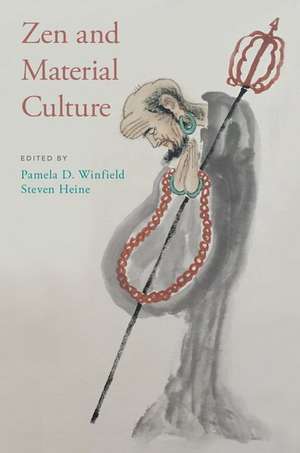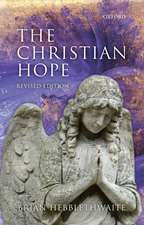Zen and Material Culture
Editat de Pamela D. Winfield, Steven Heineen Limba Engleză Paperback – 3 aug 2017
| Toate formatele și edițiile | Preț | Express |
|---|---|---|
| Paperback (1) | 308.27 lei 10-16 zile | |
| Oxford University Press – 3 aug 2017 | 308.27 lei 10-16 zile | |
| Hardback (1) | 702.95 lei 31-37 zile | |
| Oxford University Press – 18 ian 2018 | 702.95 lei 31-37 zile |
Preț: 308.27 lei
Preț vechi: 349.77 lei
-12% Nou
Puncte Express: 462
Preț estimativ în valută:
58.100€ • 61.36$ • 48.70£
58.100€ • 61.36$ • 48.70£
Carte disponibilă
Livrare economică 13-19 martie
Preluare comenzi: 021 569.72.76
Specificații
ISBN-13: 9780190469306
ISBN-10: 0190469307
Pagini: 352
Dimensiuni: 155 x 234 x 23 mm
Greutate: 0.52 kg
Editura: Oxford University Press
Colecția OUP USA
Locul publicării:New York, United States
ISBN-10: 0190469307
Pagini: 352
Dimensiuni: 155 x 234 x 23 mm
Greutate: 0.52 kg
Editura: Oxford University Press
Colecția OUP USA
Locul publicării:New York, United States
Recenzii
Winfield and Heine have done a good job in all respects: the book is not only very well edited but it is likely to become a must read for scholars and students willing to approach critically this Buddhist tradition.
The authors include four art historians and five from Buddhist studies; all are interested in deciphering the material cultures associated with Japanese Zen and dispelling long-held stereotypes in the West that Zen transcends worldly "things." By using interdisciplinary methods, they bring valuable insights on how familiar objects of Zen practice "materialize abstract idea(l)s into concrete form," making this volume an important contribution to cultural studies and Buddhist studies
The objective of Zen and Material Culture is precisely to address and examine Zen's seemingly contradictory attitude towards statues, paintings, and ritual implements ... this work urges us to forgo many of the assumptions concerning Zen that we have long taken for granted despite their flimsy foundations... It is difficult to find any flaw in this illuminating work, which has been authored by leading scholars in their respective fields... Zen and Material Culture is a must-read for all scholars and students interested in Zen Buddhism, and there is little doubt that this book would serve as a foundational text in the study of Zen Buddhist materiality for generations to follow.
Zen and Material Culture is a welcome addition to the growing arena of material studies of Japanese religions... by directly engaging the material culture of Zen Buddhism in multiple forms, this book is an important contribution to the study of Zen and Japanese culture. It can be used productively in the classroom, both in undergraduate and graduate courses, and it will surely generate further investigations.
Even the loftiest of all spiritual traditions rests on a material foundation, and this magnificent book presents that grounding for Japanese Zen with aesthetic sensitivity and historical precision. This is a truly important contribution to the study of Zen Buddhism and the always astonishing material culture of Japan.
Following current trends in the study of religion that focus on material culture and everyday 'lived' religion, this volume looks at the materiality of Japanese and American Zen, as seen in the intersections of religion, art history, and economic history... The collection fosters reconsideration of the Zen rhetoric of austerity and aniconic practice, and raises important questions about how ideas and ideals take material form. Useful for scholars of religion, Japan, Buddhism, and art history.
... by directing attention to the 'stuff' of Zen, through essays that embrace various material culture-centered approaches, the publication re-frames (or adds another dimension to) the study of Zen, which - until more recently - has privileged an academic discourse about mind over one about matter.... The essays are arranged in rough chronological order, spanning the thirteenth century in Japan to the present, inclusive of Soto, Rinzai, and Obaku contexts, but their scopes and source materials extend more broadly in time and space... the insights and methodologies the authors work through are certainly able to be incorporated into any course that touches on Zen.
Reading the volume... I came to see great value in the sort of close observation at work in these case studies as well as the synergistic effect of bringing multiple disciplines or fields together between the covers of a single volume. The editors deserve our praise and our thanks as well for putting together a cohesive and provocative collection... The [articles] are admirable both for their specificity and for their insistence on reflecting a larger picture that situates Zen as a corner of larger discourses within Japanese Buddhism... I would like to congratulate the editors and the authors for a very lively and interesting volume. It is most welcome and I know I will use chapters in my Zen class.
I agree with Pamela Winfield and Steven Heine's charge that there is a popular misconception of Zen, and Buddhism at large, as meditative or minimalist, and not concerned with worldly material possessions. I am excited that one of this edited volume's goals is to disabuse others of this notion... While there is academic attention on Buddhist financial matters in India, China, Tibet and some work on Japan, I do not see as much on Zen. Therefore, Winfield and Heine's volume is quite timely.
The authors include four art historians and five from Buddhist studies; all are interested in deciphering the material cultures associated with Japanese Zen and dispelling long-held stereotypes in the West that Zen transcends worldly "things." By using interdisciplinary methods, they bring valuable insights on how familiar objects of Zen practice "materialize abstract idea(l)s into concrete form," making this volume an important contribution to cultural studies and Buddhist studies
The objective of Zen and Material Culture is precisely to address and examine Zen's seemingly contradictory attitude towards statues, paintings, and ritual implements ... this work urges us to forgo many of the assumptions concerning Zen that we have long taken for granted despite their flimsy foundations... It is difficult to find any flaw in this illuminating work, which has been authored by leading scholars in their respective fields... Zen and Material Culture is a must-read for all scholars and students interested in Zen Buddhism, and there is little doubt that this book would serve as a foundational text in the study of Zen Buddhist materiality for generations to follow.
Zen and Material Culture is a welcome addition to the growing arena of material studies of Japanese religions... by directly engaging the material culture of Zen Buddhism in multiple forms, this book is an important contribution to the study of Zen and Japanese culture. It can be used productively in the classroom, both in undergraduate and graduate courses, and it will surely generate further investigations.
Even the loftiest of all spiritual traditions rests on a material foundation, and this magnificent book presents that grounding for Japanese Zen with aesthetic sensitivity and historical precision. This is a truly important contribution to the study of Zen Buddhism and the always astonishing material culture of Japan.
Following current trends in the study of religion that focus on material culture and everyday 'lived' religion, this volume looks at the materiality of Japanese and American Zen, as seen in the intersections of religion, art history, and economic history... The collection fosters reconsideration of the Zen rhetoric of austerity and aniconic practice, and raises important questions about how ideas and ideals take material form. Useful for scholars of religion, Japan, Buddhism, and art history.
... by directing attention to the 'stuff' of Zen, through essays that embrace various material culture-centered approaches, the publication re-frames (or adds another dimension to) the study of Zen, which - until more recently - has privileged an academic discourse about mind over one about matter.... The essays are arranged in rough chronological order, spanning the thirteenth century in Japan to the present, inclusive of Soto, Rinzai, and Obaku contexts, but their scopes and source materials extend more broadly in time and space... the insights and methodologies the authors work through are certainly able to be incorporated into any course that touches on Zen.
Reading the volume... I came to see great value in the sort of close observation at work in these case studies as well as the synergistic effect of bringing multiple disciplines or fields together between the covers of a single volume. The editors deserve our praise and our thanks as well for putting together a cohesive and provocative collection... The [articles] are admirable both for their specificity and for their insistence on reflecting a larger picture that situates Zen as a corner of larger discourses within Japanese Buddhism... I would like to congratulate the editors and the authors for a very lively and interesting volume. It is most welcome and I know I will use chapters in my Zen class.
I agree with Pamela Winfield and Steven Heine's charge that there is a popular misconception of Zen, and Buddhism at large, as meditative or minimalist, and not concerned with worldly material possessions. I am excited that one of this edited volume's goals is to disabuse others of this notion... While there is academic attention on Buddhist financial matters in India, China, Tibet and some work on Japan, I do not see as much on Zen. Therefore, Winfield and Heine's volume is quite timely.
Notă biografică
Pamela D. Winfield is Associate Professor of Religious Studies at Elon University, NC. She specializes in Japanese Buddhist art and doctrine in the esoteric and Zen traditions. Her previous book Icons and Iconoclasm in Japanese Buddhism: Kūkai and Dōgen on the Art of Enlightenment (Oxford University Press, 2013) won the annual Book Prize from the Association of Asian Studies Southeast Conference in 2015.Steven Heine is Professor of Religious Studies and History, and Director of the Asian Studies Program at Florida International University in Miami, FL. A 2007 recipient of the Order of the Rising Sun Award from the Japanese government, Heine is the author of more than two dozen books and one hundred articles and book chapters on East Asian religions, especially the role of Zen in China and Japan and the relation between religiosity and society.














